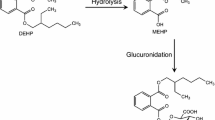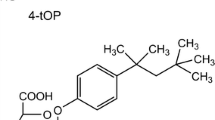Summary
The metabolism of imipramine was investigated by the incubation of C-14 labelled compound in Krebs-Ringer bicarbonate buffer with microsomes of small intestine and of liver from guinea pigs.
Imipramine and its metabolites were extracted with chloroform, separated by TLC and determined quantitatively by direct scanning with a TLC Linear Analyzer.
With intestinal microsomes, the following metabolites could be identified: DMI, 2-OH-IMP, IMP-N-oxide. DMI is the main metabolite. The same metabolites appeared after incubation with liver microsomes, but the proportions were different: the N-oxide formation was predominant, followed by N-demethylation and hydroxylation.
The formation of DMI and 2-OH-IMP seems to follow Michaelis-Menten kinetics, both in assays with intestinal and with liver microsomes.
The liver/intestine ratio of DMI and 2-OH-IMP formation is proportional to the cytochrome P-450 ratio in the microsomes, in contrast to N-oxide formation.
Similar content being viewed by others
Abbreviations
- IMP:
-
imipramine
- DMI:
-
N-monodesmethyl-imipramine
- 2-OH-IMP:
-
2-hydroxy-imipramine
- IMP-N-oxide:
-
imipramine-N-oxide
References
Bickel MH (1971a) N-Oxide formation and related reactions in drug metabolism. Xenobiotica 1:313–319
Bickel MH (1971b) Liver metabolic reactions: Tertiary amine N-dealkylation, tertiary amine N-oxidation, N-oxide reduction, and N-oxide N-dealkylation. I. Tricyclic tertiary amine drugs. Arch Biochem Biophys. 148:54–62
Bickel MH (1980) Metabolism of antidepressants. In: Hoffmeister F, Stille G (eds) Psychotropic agents, Part I: Antipsychotics and antidepressants. Handbook of experimental pharmacology, vol 55/I. Springer, Berlin Heidelberg New York, pp. 551–572
Bickel MH, Weder HJ (1968) Demethylation of imipramine in the rat as influenced by SKF-525 A and by different routes of administration. Life Sci 7:1223–1230
Bock KW, Winne D (1975) Glucuronidation of 1-naphthol in the rat intestinal loop. Biochem Pharmacol 24:859–862
Breyer U, Winne D (1977) Absorption and metabolism of the phenothiazine drug perazine in the rat intestinal loop. Biochem Pharmacol 26:1275–1280
Buening MK, Franklin MR (1974) The formation of complexes absorbing at 455 nm from cytochrome P-450 and metabolites of compounds related to SKF 525 A. Drug Metab Disp 2:386–390
Cornish-Bowden A, Eisenthal R (1974b) Statistical considerations in the estimation of enzyme kinetic parameters by the direct linear plot and other methods. Biochem J 139:721–730
Daniel W, Adamus A, Melzacka M, Szymura J (1982) The route of administration of imipramine as a factor affecting formation of its metabolite desipramine. J Pharm Pharmacol 34:678–680
Dawson JR, Bridges JW (1981) Intestinal microsomal drug metabolism. A comparison of rat and guinea pig enzymes, and of rat crypt and villous tip cell enzymes. Biochem Pharmacol 30:2415–2420
Dencker H, Dencker SJ, Green A, Nagy A (1976) Intestinal absorption, demethylation, and enterohepatic circulation of imipramine. Clin Pharmacol Ther 19:584–586
Eisenthal R, Cornish-Bowden A (1974a) The direct linear plot. Biochem J 139:715–720
Gillette JR, Dingell JV, Sulser F, Kuntzman R, Brodie BB (1961) Isolation from rat brain of a metabolic product, desmethylimipramine, that mediates the antidepressant activity of imipramine. Experientia 17:417–418
Gorrod JW (1973) Differentiation of various types of biological oxidation of nitrogen in organic compounds. Chem Biol Interact 7: 289–303
Harris SR, Gaudette LE, Efron DH, Manian AA (1970) A method for the measurement of plasma imipramine and desmethylimipramine concentrations. Life Sci 9 (Part I):781–788
Hlavica P, Kehl M (1977) Mechanism of N-oxide formation by hepatic mixed function oxidases. In: Ullrich V, Hildebrandt A, Roots I, Estabrook RW, Conney AH (eds) Microsomes and drug oxidations. Pergamon Press, Oxford New York, pp 346–353
Knoll R, Christ W, Müller-Oerlinghausen B, Coper H (1977) Formation of chlorpromazine sulphoxide and monodesmethylchlorpromazine by microsomes of small intestine. Naunyn-Schmiedeberg's Arch Pharmacol 297:195–200
Lenk W (1976) Application and interpretation of kinetic analyses from the microsomal drug metabolizing oxygenases. Biochem Pharmacol 25:997–1005
Metyšova J, Metyš J (1965) Pharmacological properties of the desmethylderivatives of some antidepressants of imipramine type. Int J Neuropharmacol 4:111–124
Michaelis W, Stille G (1968) Demethylation of imipramine and anti-tetrabenazine effect in the catalepsy and ptosis test. Life Sci 7:99–106
Minder R, Schnetzer F, Bickel MH (1971) Hepatic and extrahepatic metabolism of the psychotropic drugs chlorpromazine, imipramine and imipramine-N-oxide. Naunyn-Schmiedeberg's Arch Pharmakol 268:334–347
Moldowan M, Bellward GD (1974) Studies of14C-imipramine metabolism in the isolated perfused rat liver. Can J Physiol Pharmacol 52:441–450
Nagy A (1977) Blood and brain concentrations of imipramine, clomipramine and their monomethylated metabolites after oral and intramuscular administration in rats. J Pharm Pharmacol 29:104–107
Nakazawa K (1970) Studies on the demethylation, hydroxylation and N-oxidation of imipramine in rat liver. Biochem Pharmacol 19:1363–1369
Ohmiya Y, Mehendale HM (1980) N-Oxidation of imipramine by isolated perfused rat and rabbit lung. Life Sci 26:1411–1421
Ohmiya Y, Mehendale HM (1981) Pulmonary metabolism of imipramine in the rat and rabbit. Comparison with hepatic metabolism. Pharmacology 22:172–182
Pinkus LM, Ketley JN, Jacoby WB (1977) The glutathione-S-transferases as a possible detoxification system of rat intestinal epithelium. Biochem Pharmacol 26:2359–2363
Potter WZ, Calil HM, Sutfin TA, Zavadil III AP, Jusko WJ, Rapoport J, Goodwin FK (1982) Active metabolites of imipramine and desipramine in man. Clin Pharmacol Ther 31:393–402
Rance MJ, Shillingford JS (1976) The role of the gut in the metabolism of strong analgesics. Biochem Pharmacol 25:735–741
Sakalis G, Chan TL, Gershon S, Park S (1973) The possible role of metabolites in therapeutic response to chlorpromazine treatment. Psychopharmacologia 32:279–284
Schenkman JB, Remmer H, Estabrook RW (1967) Spectral studies of drug interaction with hepatic microsomal cytochrome. Mol Pharmacol 3:113–123
Stille G (1968) Pharmacological investigation of antidepressant compounds. Pharmakopsychiatr Neuropsychopharmakol 1:92–106
Stille G, Michaelis W (1970) Imipramine demethylation and norepinephrine storage in brain. Eur J Pharmacol 10:355–359
Sulser F, Watts J, Brodie BB (1962) On the mechanism of anti-depressant action of imipramine-like drugs. Ann NY Acad Sci 96:279–286
Theobald W, Büch O, Kunz HA, Morpurgo C (1966) Zur Pharmakologie von Metaboliten des Imipramins. Med Pharmacol Exp 15:187–197
Wirth PJ, Thorgeirsson SS (1978) Amine oxidase in mice-sex differences and developmental aspects. Biochem Pharmacol 27:601–603
Ziegler DM, Mitchell CH, Jollow D (1969) The properties of a purified hepatic microsomal mixed function amine oxidase. In: Gillette JR, Conney AH, Cosmides GJ, Estabrook RW, Fouts JR, Mannering GJ (eds) Microsomes and drug oxidations. Academic Press, New York London, pp 173–188
Author information
Authors and Affiliations
Rights and permissions
About this article
Cite this article
Christ, W., Hecker, W., Junge, H. et al. Phase I metabolism of imipramine by microsomes of small intestine in comparison with metabolism by liver microsomes. Naunyn-Schmiedeberg's Arch. Pharmacol. 323, 176–182 (1983). https://doi.org/10.1007/BF00634268
Received:
Accepted:
Issue Date:
DOI: https://doi.org/10.1007/BF00634268




